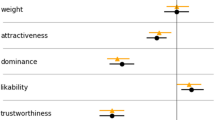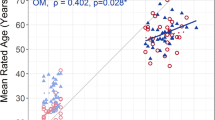Abstract
This book comprises contributions on vocal aspects of attractiveness, social likability, and charisma. Despite some apparent distinct characteristics of these three concepts, there are not only similarities, but even interdependencies to be considered. This chapter introduces and regards the concepts studied, methods applied, and material selected in the contributions. Based on this structured summary, we argue to increase interdisciplinary and even holistic efforts in order to better understand the concepts for voice and speech in humans and machines.
Access this chapter
Tax calculation will be finalised at checkout
Purchases are for personal use only
Similar content being viewed by others
Notes
- 1.
Signals are traits that have evolved specifically because they change the behavior of receivers in ways that benefit the signaler. For example, peacock resplendent tail feathers are honest since they truly signal reproductive fitness of their bearer to the receiver.
- 2.
The waist-to-hip ratio (WHR) is the dimensionless ratio of the circumference of the waist to that of the hip. WHR correlates with health and fertility (with different optimal values in males and females).
References
Abele, A. E., Cuddy, A. J. C., Judd, C. M., & Yzerbyt, V. Y. (2008). Fundamental dimensions of social judgment. Editorial to the Special Issue. European Journal of Social Psychology, 38(7), 1063–1065.
Argyle, M. (1988). Bodily Communication. New York: Methuen.
Banse, R., & Scherer, K. (1996). Acoustic profiles in vocal emotion expression. Journal of Personality and Social Psychology, 70(3), 614–636.
Bezooijen, R. V. (1995). Sociocultural aspects of pitch differences between Japanese and Dutch women. Language and Speech, 38, 253–265.
Brown, B. L., Strong, W. J., & Rencher, A. C. (1973). Perceptions of personality from speech: effects of manipulations of acoustical parameter. Journal of the Acoustical Society of America, 54(1), 29–35.
Brown, B. L., Giles, H., & Thakerar, J. N. (1985). Speaker evaluation as a function of speech rate, accent, and context. Language and Communication, 5(3), 207–220.
Cuddy, A. J., Fiske, S. T., & Glick, P. (2008). Warmth and competence as universal dimensions of social perception: The stereotype content model and the BIAS map. Advances in Experimental Social Psychology, 40, 62–149.
Darwin, C. (1890). The Expression of the Emotions in Man and Animals. London: John Murray.
DePaulo, B. M., Kenny, D. A., Hoover, C. W., Webb, W., & Oliver, P. V. (1987). Accuracy of person perception: Do people know what kinds of impressions they convey? Journal of Personality and Social Psychology, 52(2), 303–315.
Fiske, S. T., Cuddy, A. J., & Glick, P. (2006). Universal dimensions of social cognition: Warmth and competence. Trends in Cognitive Sciences, 11(2), 77–83.
Hart, R. J., & Brown, B. L. (1974). Personality information contained in the verbal qualities and in content aspects of speech. Speech Monographs, 41, 271–380.
Krause, S., Back, M. D., Egloff, B., & Schmukle, S. C. (2014). Implicit interpersonal attraction in small groups automatically activated evaluations predict actual behavior toward social partners. Social Psychological and Personality Science, 20, 671–679.
Laver, J., & Trudgill, P. (1979). Phonetic and linguistic markers in speech. In K. R. Scherer & H. Giles (Eds.), Social Markers in Speech (pp. 1–32). Cambridge: Cambridge University Press.
Laver, J. (1980). The Phonetic Description of Voice Quality. Cambridge: Cambridge University Press.
McAleer, P., Todorov, A. & Berlin, P. (2014). How do you say ’Hello’? Personality impressions from brief novel voices. PLOS ONE 9(3).
McCroskey, J., & McCain, T. (1974). The Measurement of Interpersonal Attraction. Speech Monographs, 41, 261–266.
Mori, M. (2012). The uncanny valley. IEEE Robotics and Automation 19(2). Originally 1970, Translated by MacDorman, K.F. & Kageki, N., pp. 98–100.
Nass, C., & Brave, S. (2005). Wired for Speech. How Voice Activates and Advances the Human-Computer Relationship. MIT Press.
Nass, C., Moon, Y., Fogg, B., Reeves, B., & Dryer, D. (1995). Can computer personalities be human personalities? International Journal of Human-Computer Studies, 43, 223–239.
Ohala, J. (1984). An ethological perspective on common cross-language utilization of F0 of voice. Phonetica, 41, 1–16.
Paeschke, A., & Sendlmeier, W. F. (1997). Die Reden von Rudolf Scharping und Oskar Lafontaine auf dem Parteitag der SPD im November 1995 in Mannheim –Ein sprechwissenschaftlicher und phonetischer Vergleich von Vortragsstilen. Zeitschrift für Angewandte Linguistik, 27, 5–39.
Putnam, W. B., & Street, R. L. J. (1984). The conception and perception of noncontent speech performance: Implications for speech-accommodation theory. International Journal of the Sociology of Language, 46, 97–114.
Reeves, B., & Nass, C. (1996). The Media Equation: How People Treat Computers, Television, and New Media Like Real People and Places. Cambridge: Cambridge University Press.
Schaller, M. (2008). Evolutionary basis of first impressions. In N. Ambady & J. J. Skowronski (Eds.), First Impressions (pp. 15–34). New York: Guilford Press.
Scherer, K. R. (1978). Personality inference from voice quality: The loud voice of extroversion. European Journal of Social Psychology, 8(4), 467–487.
Schweitzer, A., Lewandowski, N., Duran, D., & Dogil, G. (2015). Attention, please!—Expanding the GECO database. In Proceedings of the 18th International Congress of Phonetic Sciences, Glasgow, paper 620.
Street, Jr. R. L., & Brady, R. M. (1982). Speech rate acceptance ranges as a function of evaluative domain, listener speech rate and communication context. Communication Monographs 49(4), 290–308.
Weirich, M. (2010). Die attraktive Stimme: Vocal Stereotypes. Eine phonetische Analyse anhand akustischer und auditiver Parameter. Saarbrücken: Verlag Dr. Müller.
Weiss, B., Wechsung, I., Kühnel, C., & Möller, S. (2015). Evaluating embodied conversational agents in multimodal interfaces. Computational Cognitive Science, 1(6), 1–21.
Weiss, B., & Möller, S. (2011). Wahrnehmungsdimensionen von Stimme und Sprechweise. 22. Konferenz Elektronische Sprachsignalverarbeitung, Aachen, pp. 261–268.
Zuckermann, M., & Driver, R. E. (1989). What sounds beautiful is good: The vocal attractiveness stereotype. Journal of Nonverbal Behaviour, 13, 67–82.
Author information
Authors and Affiliations
Corresponding author
Editor information
Editors and Affiliations
Rights and permissions
Copyright information
© 2021 Springer Nature Singapore Pte Ltd.
About this chapter
Cite this chapter
Trouvain, J., Weiss, B., Barkat-Defradas, M. (2021). Voice Attractiveness: Concepts, Methods, and Data. In: Weiss, B., Trouvain, J., Barkat-Defradas, M., Ohala, J.J. (eds) Voice Attractiveness. Prosody, Phonology and Phonetics. Springer, Singapore. https://doi.org/10.1007/978-981-15-6627-1_1
Download citation
DOI: https://doi.org/10.1007/978-981-15-6627-1_1
Published:
Publisher Name: Springer, Singapore
Print ISBN: 978-981-15-6626-4
Online ISBN: 978-981-15-6627-1
eBook Packages: Social SciencesSocial Sciences (R0)




